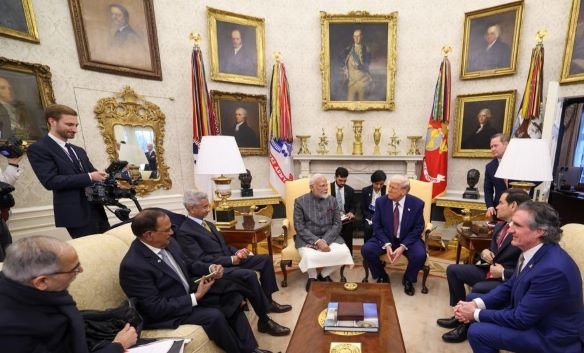Trump’s Reciprocal Tariffs to Hit India Hard
President Donald Trump’s recent announcement of reciprocal tariffs on all US trading partners has triggered widespread concern and uncertainty in global trade circles. This move, unveiled ahead of his meeting with Prime Minister Narendra Modi, seeks to address trade imbalances by imposing tariffs equivalent to those levied by other nations on US goods. India, which has comparatively higher tariffs on US exports, is expected to be among the most impacted nations.
India’s High Tariff Structure Under Scrutiny
India’s tariff rates on US imports are significantly higher than those imposed by the US on Indian goods. According to analysts at Nomura, India’s weighted average effective tariff on US exports stands at 9.5%, whereas the US levies only around 3% on Indian products.
President Trump highlighted this imbalance, stating, “They can build a factory here, a plant, or whatever it may be, and that includes the medical, that includes cars, that includes chips and semiconductors, that includes everything.” He further added, “If you build here, you have no tariffs whatsoever. And I think that’s what’s going to happen. I think our country is going to be flooded with jobs.”
Impact on Key Indian Sectors
The reciprocal tariffs could have wide-ranging effects on several Indian industries, particularly those reliant on US markets. Analysts predict that India’s food products, vegetables, textiles, and clothing sectors will be among the hardest hit. Additionally, major exports such as electrical machinery, gems and jewelry, pharmaceutical products, automobiles, and iron and steel are likely to face increased costs and reduced competitiveness in the US market.
Ahead of his meeting with PM Modi, Trump reinforced his stance on India’s trade policies, stating, “India is a hard place to do business because of the high tariffs. But again, whatever they charge us, we’re charging them. So, it works out very well. It’s a beautiful, simple system, and we don’t have to worry about charging too much or too little.”
India’s Response and Possible Trade Adjustments
To mitigate trade tensions, India is reportedly exploring the possibility of reducing tariffs on over 30 products and increasing its imports of US defense and energy goods. However, given the complexities of Indo-US trade relations, any adjustments may take time and negotiations could be challenging.
With the new tariffs expected to take effect as early as April, Indian businesses exporting to the US are bracing for potential disruptions. Analysts suggest that the policy shift could lead to higher prices for consumers and increased production costs for exporters.
Global Implications of the Reciprocal Tariffs
Beyond India, other major economies such as Japan and the European Union are also expected to feel the impact of Trump’s tariff policy. The move represents a significant shift in US trade strategy and could have broader repercussions on global trade relationships.
In the short term, the tariffs may lead to rising costs for consumers and exporters. However, in the long run, the US administration argues that the policy could create a more balanced trade environment. How India and other affected nations navigate these new trade challenges will be crucial in determining the future of global commerce.
Also see:
Indians Dominate H-1B Visas: 72% of Allocations Between Oct 2022 & Sept 2023
H-1B Visa Registration Opens on March 7; Fee Hike
Trudeau Calls Trump’s Canada Annexation Threat a “Real Concern”
Gautam Adani Donates Rs 10,000 Crore to Social Causes at Son’s Wedding
—————————————————————
It would mean the world to us if you follow us on Twitter, Instagram and Facebook




